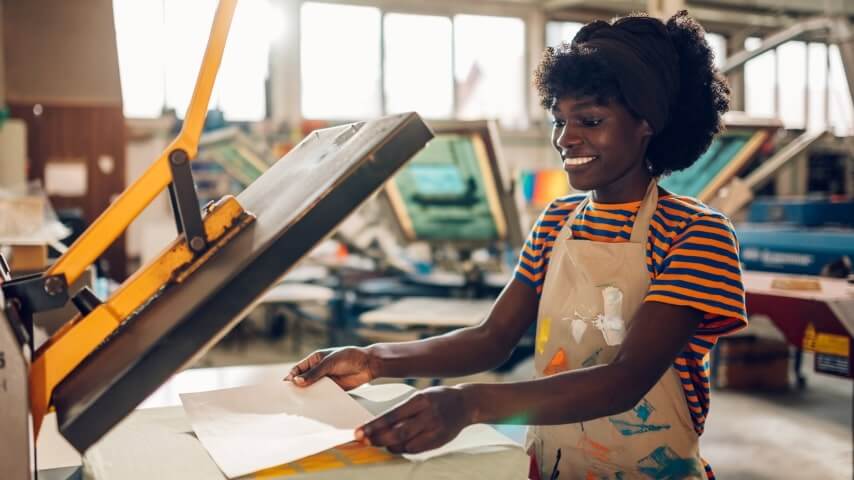
The Ultimate Guide to Profiting from DTF (Direct-to-Film) Printing
If you’re looking to break into the custom merchandise business, choosing the right printing method is essential. One printing technique that stands out for its vibrant prints, versatility, and durability is Direct-to-Film (DTF) printing. Not only is it capable of producing high-quality designs, but it’s also ideal for a wide range of materials, making it a popular choice for sellers in the custom apparel market.
In this post, we’ll explore what DTF printing is, how it works, and how you can leverage it to make money online.
Key Takeaways:
- How it works: DTF printing uses heat transfer to apply designs to fabrics and other materials. It requires a DTF printer, PET film, adhesive powder, and a high-resolution design.
- Quality and durability: DTF prints are long-lasting and vibrant, capable of withstanding frequent washes and wear.
- Versatility: DTF works on various fabrics like cotton, polyester, blends, and even non-textile surfaces like leather or wood.
- Merchandising potential: Klothing offers print-on-demand DTF options, making it easy to start your custom t-shirt or product line.
Table of Contents:
- What Is Direct-to-Film Printing?
- How Does DTF Printing Work?
- Pros and Cons of DTF Prints
- DTF vs. DTG Printing
- DTF vs. Sublimation Printing
- DTF vs. Screen Printing
- How to Get Started with DTF Printing Through Klothing
- FAQs
1. What Is Direct-to-Film Printing?
Direct-to-film (DTF) printing is a digital printing method where designs are printed onto a special PET film, which is then transferred to fabric or other materials using a heat press. The process doesn’t require pre-treatment of fabric, which simplifies production compared to other methods like DTG (Direct-to-Garment).
With DTF printing, you can print on fabrics like:
- Cotton
- Polyester
- Blends
- Leather
- Nylon
- Even non-textile materials such as wood
Because of its precision and color vibrancy, DTF is ideal for intricate designs, offering sellers flexibility in creating a variety of products.
2. How Does DTF Printing Work?
The DTF process involves a few key steps:
- Design Creation: Use graphic design software like Photoshop or Illustrator to create a high-resolution image. Export the design as a PNG with a transparent background.
- Print Setup: A DTF printer is loaded with specialized inks, including CMYK and white ink for base layers. The design is printed onto a PET film.
- Adhesive Application: The freshly printed film is dusted with a hot-melt adhesive powder, which adheres to the wet ink.
- Heat Transfer: After curing the powder, the film is applied to the fabric using a heat press. The film is then peeled away, leaving a vibrant, durable design on the product.
3. Pros and Cons of DTF Prints
Pros:
- Versatile: Works on a wide variety of fabrics and materials.
- Vibrant Prints: Produces bright, long-lasting designs.
- No Fabric Pre-Treatment: Saves time compared to DTG.
- Cost-Effective: Perfect for small to medium print runs with intricate designs.
Cons:
- Requires Careful Handling: Adhesive powder can be messy.
- Specialized Materials: DTF requires specific PET film and adhesive, increasing operational costs.
- Equipment Maintenance: DTF printers need regular maintenance to ensure quality prints.
4. DTF vs. DTG Printing
While DTF prints designs onto a film and transfers them to fabric, DTG (Direct-to-Garment) prints directly onto the fabric. Here’s how they compare:
- Versatility: DTF works on more fabric types and doesn’t require pre-treatment.
- Efficiency: DTF is faster for medium to large runs, while DTG is ideal for small batches.
- Cost: DTG equipment and pre-treatment processes can be more expensive.
5. DTF vs. Sublimation Printing
Sublimation printing is ideal for polyester-based materials, but it’s not suitable for cotton or dark-colored fabrics. DTF, on the other hand, works on a variety of fabric types, making it more versatile for custom products.
6. DTF vs. Screen Printing
Screen printing is more suited for bulk orders due to its cost-efficiency for large runs. DTF, however, excels with intricate designs and smaller batches, offering greater flexibility and quicker setup times.
7. How to Get Started with DTF Printing Through Klothing
You don’t need to invest in expensive equipment to get started with DTF printing. Klothing offers print-on-demand DTF services, allowing you to create custom products without upfront costs. Here’s how:
- Choose Your Product: Browse Klothing’s catalog for DTF-compatible products.
- Upload Your Design: Use the Product Creator to apply your design.
- Start Selling: Once your products are set, you can begin selling through your eCommerce store, with Klothing handling fulfillment.
8. FAQ
Which is better, DTF or sublimation?
DTF is more versatile across fabrics, while sublimation works best for polyester materials and certain hard surfaces.
Does DTF printing last long?
Yes, DTF prints are highly durable and can withstand frequent washing without fading or cracking.
What is a DTF transfer?
A DTF transfer involves printing a design onto PET film, applying adhesive powder, and transferring it onto fabric with heat.
Summary
DTF printing is a game-changer for custom product sellers, offering vibrant, durable designs on a wide range of materials. Whether you’re starting a custom apparel line or expanding your product offerings, DTF printing provides the versatility and quality needed to succeed.
Explore DTF printing with Klothing Canada today and start building your custom merchandise empire!
